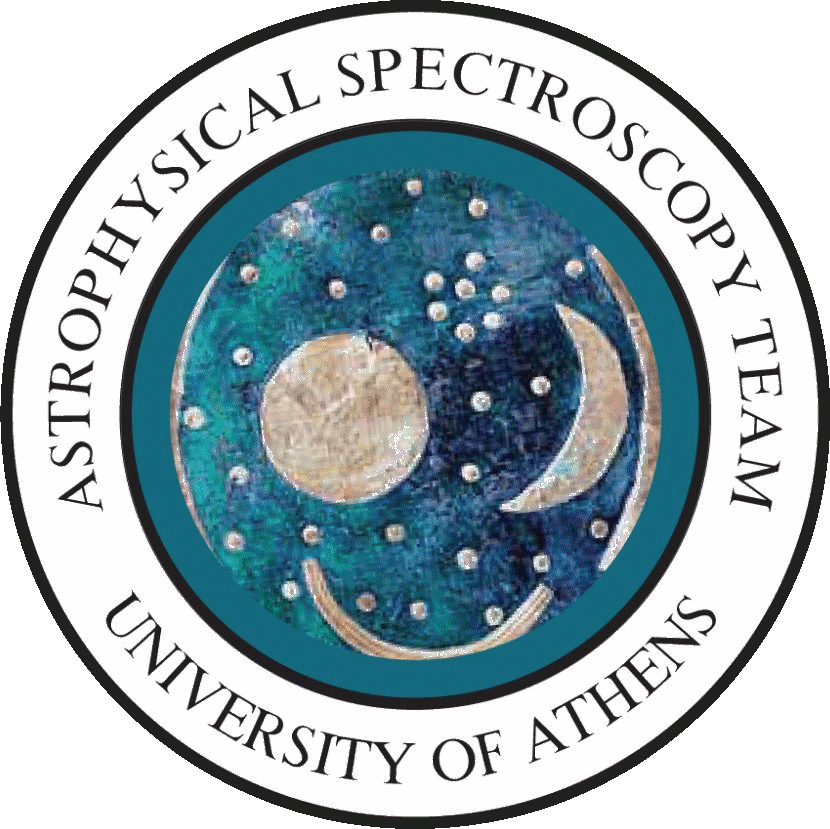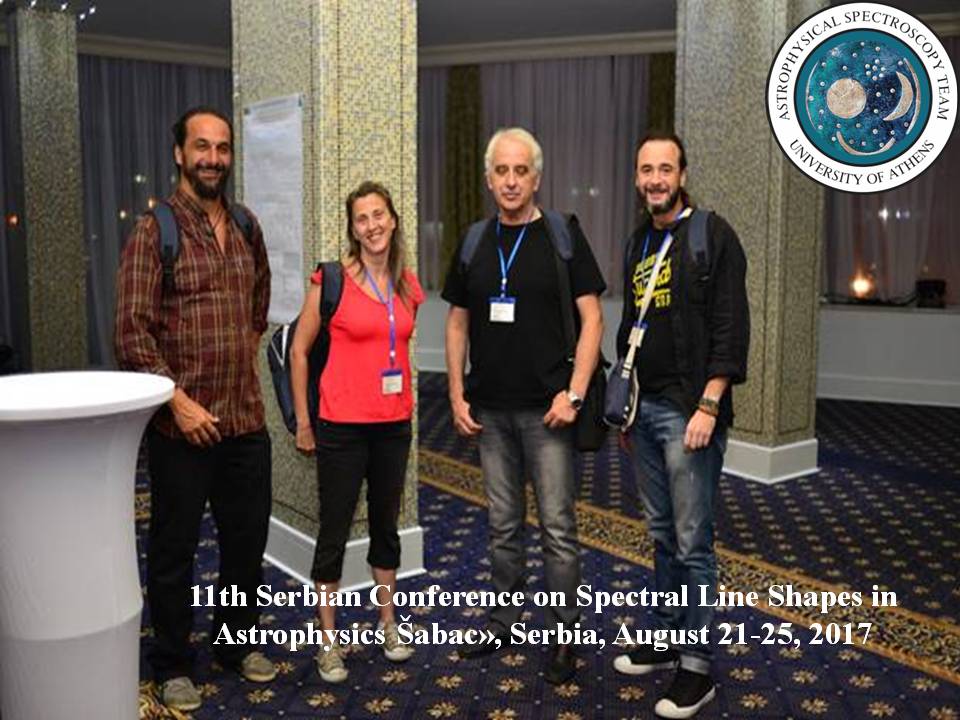(11th Serbian Conference on Spectral Line Shapes in Astrophysics, Šabac»,Serbia, August 21-25, 2017)
The Astronomical Spectroscopy Research Team of the Department of Physics of the National and Kapodistrian University of Athens participated in the international conference "11th Serbian Conference on Spectral Line Shapes in Astrophysics, Šabac", Serbia, August 21-25, 2017.
At the next website you can find all the scientific and social information about the conference
http://www.scslsa.matf.bg.ac.rs/index...
At this conference Dr. E. Lyratzi
http://www.spectroscopyteam.edu.gr/index.php/team/dr-evangelia-lyratzi
replaced Prof.E. Danezis as a permanent member of the Scientific Committee of the Congress
Screenshots from the participation of the Spectroscopy team of the University of Athens at the conference can be found at:
https://www.youtube.com/watch?v=P8oqsHQ9bvM&t=3s&index=2&list=PL1yPaYDIYvXEfGJQQ8hL21z4dxOWQgF3a
Three research papers from members of our research team have been presented at this conference which have expanded the positions that our research team has formulated twenty years ago in order to answer in a series of big questions concerning the Hot Emission Stars and Quasars, and which have been confirmed both theoretically and experimentally over the last five years.
The ASTA software was officially presented at this conference.
http://www.spectroscopyteam.edu.gr/index.php/asta-software/documentation
This software expressing the GR model that has been proposed by our research team many years ago, gave us the opportunity to answer a series of scientific questions that were awaiting an answer
http://www.spectroscopyteam.edu.gr/index.php/educational-material
Below, we present the abstract of the presentations while on the following web pages we present the ppt of the lectures:
https://www.youtube.com/watch?v=beTyKwCPWz8&list=PL1yPaYDIYvXEeA6S8c7kdZz-dRdgbZ8MS&index=27
https://www.youtube.com/watch?v=Yr3d9zGMkKM&list=PL1yPaYDIYvXEeA6S8c7kdZz-dRdgbZ8MS&index=22
https://www.youtube.com/watch?v=I1l3qzndV6g
ASTA Software: An Advanced Spectral Analysis Algorithmic Environment for Emission and Absorption Line Spectra
D. Tzimeas1, D. Stathopoulos1,2, E Danezis1, E. Lyratzi1,2, A. Antoniou1
1University of Athens, Faculty of Physics, Department of Astrophysics, Astronomy and
Mechanics, Panepistimioupoli, Zographou 157 84, Athens, Greece
2Eugenides Foundation, 387 Sygrou Av., 175 64, Athens, Greece
As we know DACs (in the case of Hot Emission Stars) and BALs (in the case of Quasars) are spectral lines of the same ion and the same wavelength as the main spectral line, shifted at different ∆λ, as they are created in different density regions which rotate and move radially with different velocities.
The currently accepted view is that BALs and DACs may be due to a flow of many individual density enhancements, called clouds, cloudlets or clumps which are optically thick and very small compared with the size of the central continuum source. These density enhancements are not preexisting entities but are formed inside an unstable and turbulent wind.
A second interesting point is that BALs/DACs indicate very complex profiles. According to this phenomenon, a prevailing view is that BALs/DACs are not simple absorption lines, but the synthesis of a group of classical absorption line components of the same spectral line.
These complex structures of BALs/DACs pose a series of questions:
Can BALs be simulated and analyzed taking into account their complex structure and large widths? How can Si IV and C IV BALs be analyzed? Accepting the point of view that BALs are the synthesis of a series of components, is there a way to study not only the whole profile but the profiles of each individual component (line function of each individual absorber in the line of sight)? Which is the interpolation polynomial that describes the whole BAL profile? In the case of multiple BAL which is the interpolation polynomial that describes the whole absorbing region? Can the two members of the resonance doublets (f. e Si IV and C IV) be studied independently? Until now the BALs/DACs doublets the resonance doublets (f. e C IV and Si IV are considered one spectral line.
In order to answer in this set of questions Astrophysical Spectroscopy Team of the National and Kapodistrian University of Athens constructed the GR model which incorporates all the previously mentioned characteristics.
At this point it is clear that we need to create a software capable, not only to run GR model but to help accelerate complex mathematical precision checks and confirm the uniqueness of the calculated physical parameters and the number of the absorption components that construct every BAL/DAC. This is the software A.S.T.A. (Astrophysical Team of Athens) which we present in a package with the manual and some information about the mathematical structure of GR Model.
The package AS.T.A will be available free to the scientific community.
On the website:
https://www.youtube.com/watch?v=beTyKwCPWz8
You can find the ppt of previous presentation. Soon (and before publishing in international journals) the text of the presentations will be posted
Long term variability of Si IV and C IV broad absorption troughs of 10 BALQSOs
MSc D. Stathopoulos
PhD Candidate
National and Kapodistrian University of Athens, Faculty of Physics Department of Astrophysics, Astronomy and Mechanics, Panepistimioupoli, Zographou 157 84, Athens, Greece
Abstract
Broad absorption lines (BALs) in quasar spectra identify powerful and high velocity outflows emanating from the central regions that power the QSOs. The structure, evolution and physical properties of these outflows still remain open questions. A method that can provide useful information that could potentially help answer these questions, is variability of broad absorption lines. In this paper we study the variability of BALs by performing multicomponent analysis of Si IV and C IV broad absorption troughs in the case of 10 BALQSOs. By analyzing each Si IV and C IV BAL trough to the individual and uniquely determined components it consists of, we are able to study not only the variability of the whole absorption trough but also the variability of each individual components that contributes to the formation of a BAL. As a consequence, we have the advantage to study the variations of the individual absorbing systems in the line of sight. We do not find any evidence of acceleration as the velocity shifts of individual components for all studied BALQSOs do not change as a function of time. Furthermore, the FWHMs of individual components remain constant as a function of time. In our sample of 10 BALQSOs, all variable components show changes in the optical depths at line centers which are manifested as variations in the EW of the components. In general, Si IV has higher incidence of variability than C IV and in cases where both ions vary over corresponding velocities, Si IV is more variable than C IV. From our analysis, evidence is in favor of different covering fractions between C IV and Si IV. Finally, although most of our results favor the crossing cloud scenario as the cause of variability, there is also strong piece of evidence indicating changing ionization as the source of variability. Thus, a mixed situation where both physical mechanisms contribute to BAL variability is the most possible scenario.
On the website:
https://www.youtube.com/watch?v=Yr3d9zGMkKM&list=PL1yPaYDIYvXEeA6S8c7kdZz-dRdgbZ8MS&index=22
you can find the ppt of previous presentation
An extensive text will soon be posted
Timescale variation of the components that form the C IV and Si IV DACs in the UV spectrum of the O-star HD 93521
A. Antoniou1, E. Danezis1, E. Lyratzi1, 2, D. Stathopoulos1 and D. Tzimeas1
1 Address: National and Kapodistrian University of Athens, Faculty of Physics Department of Astrophysics, Astronomy and Mechanics, Panepistimioupoli, Zographou 157 84, Athens, Greece
2 Address: Eugenides Foundation, 387 Sygrou Av., 17564, Athens, Greece
Abstract
In this paper we analyze the C IV and Si IV broad absorption troughs in the O-star HD 93521, in four different periods in a time interval of 16 years, to the individual components they consists of.
By analyzing a DAC/SAC trough to its components we have the advantage to study the variations of the individual absorbing systems in the line of sight and not just the variations of the whole absorption trough or the variations of selected portions of DAC troughs exhibiting changes.
Specifically, we examine the timescale variation of the radial velocities as well as the line fluxes of these absorption components. Our aim is to test the idea that DACs complex profiles are the product of individual components, originating from a series of dense plasma regions embedded in an expanding stellar wind, can be confirmed through the variability of DACs absorption troughs.
On the website:
https://www.youtube.com/watch?v=I1l3qzndV6g
you can find the ppt of previous presentation
An extensive text will soon be posted

